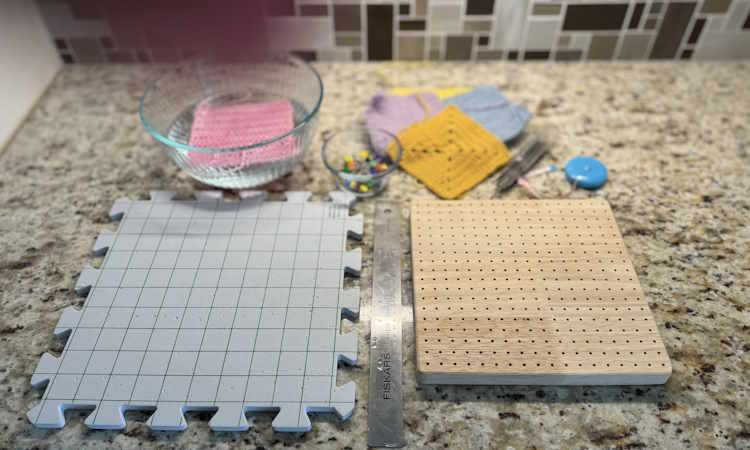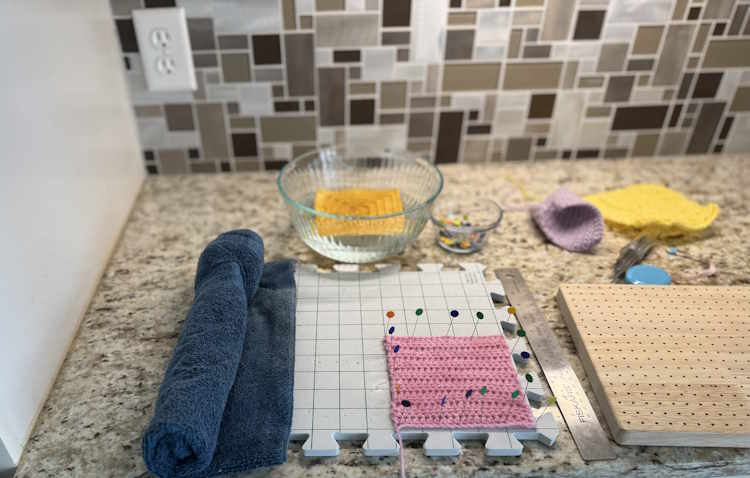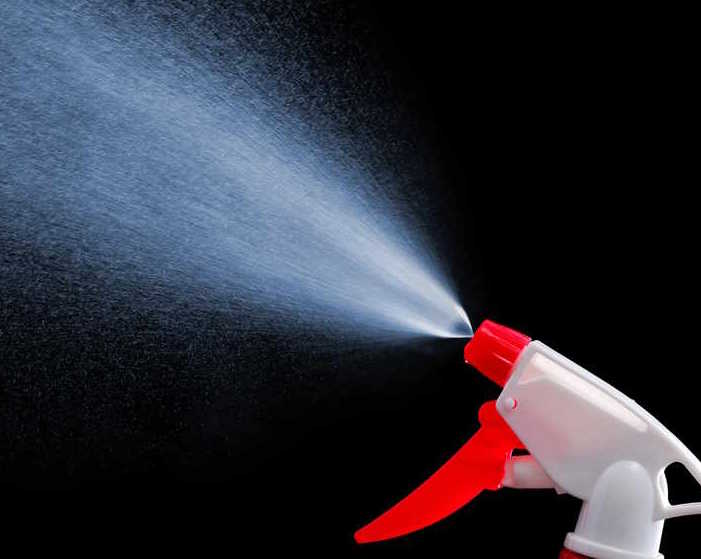- Home
- How to Crochet
- Blocking Crochet Projects
Blocking Crochet Projects: Everything You Need to Know
Blocking Crochet Projects by Janice
Are you wondering why you need to block your crochet projects? It’s understandable, especially for those little projects that appear to lay flat on their own and don’t need additional attention. I was guilty of this initially, bypassing the process.
The truth is that blocking your crochet fabric will make your handmade creation look polished and very professional. I found that out the hard way, and I hope I can convince you that blocking will help your crocheting projects achieve a more finished look.

What is Blocking in Crochet?
Blocking is an essential technique in crochet that involves shaping and stretching your finished piece to improve its appearance and fit.
It is especially beneficial for projects made with natural fibers like wool or cotton, as these materials tend to curl or lose shape over time. By blocking your crochet projects, you can ensure they retain their desired shape and drape beautifully.
There are several different methods of blocking in crochet, each with its unique benefits and drawbacks.
The most common methods include wet blocking, steam blocking, and spray blocking. Depending on the type of yarn, stitch pattern, and desired outcome, you can choose the best method for your project.
Do All Crochet Projects Need to be Blocked?
Most crochet projects benefit from some blocking, but there are exceptions. Amigurumi projects usually are not blocked.
Three-dimensional projects such as baskets, Halloween pumpkins, crochet flowers, and the like typically don't need blocking.
Benefits of Blocking Crochet Projects
Blocking your crochet projects offers numerous benefits that significantly enhance your work's overall appearance and quality. Here are some of the key advantages:
- Even stitches: Blocking helps to even out any irregularities in your stitches, resulting in a more polished and professional look.
- Improved drape: Blocking allows your crochet piece to drape more beautifully and naturally by relaxing the fibers.
- Shape retention: Blocking ensures your project maintains its intended shape, preventing it from stretching out or losing its form over time.
- Enhanced stitch definition: Blocking can bring out the intricate details of your stitch pattern, making it more visually appealing.
- Better fit: For wearable crochet items, blocking can help achieve the perfect fit by stretching or reshaping certain areas as needed.
Supplies Needed for Blocking
Depending on the type of blocking method you chose, the following supplies are needed:
- Spray bottle
- Garment steamer or steam iron
- Towels
- Blocking foam boards or substitutes such as a child's foam play mat, yoga mat, or large piece of cardboard
- Rust-proof pins
- Wooden blocking board and pegs (more about that later)
- Wool wash (ideal but not essential)
- Container for lukewarm water
- Ruler, Tape measure

Three Different Methods of Blocking Crochet Projects
Wet blocking
Wet blocking is one of the most common methods for blocking crochet projects. It involves soaking your finished piece in lukewarm water, gently squeezing the excess moisture, and then shaping it to the desired dimensions.
Pros of wet blocking:
- Effective for natural fibers like wool and cotton
- Allows for significant shaping and stretching
- It can be used to block both small and large projects
Cons of wet blocking:
- Requires more time for drying
- Not suitable for delicate or synthetic yarns
- It may cause color bleeding in specific yarns
Steam blocking

Steam blocking is a quicker alternative to wet blocking, especially suitable for projects made with delicate or synthetic yarns. It involves using steam from an iron or steamer to relax the fibers and reshape the crochet piece.
Pros of steam blocking:
- Quick drying time
- Suitable for delicate or synthetic yarns
- Ideal for projects that require minimal shaping
Cons of steam blocking:
- Less effective for heavy shaping or stretching
- Requires caution to avoid scorching or damaging the yarn
- It may not be suitable for all types of fibers
Spray Blocking

Spray blocking is a convenient method that involves misting your crochet piece with water or a blocking spray. After spraying, you gently shape and stretch the project to the desired dimensions.
Pros of spray blocking:
- Quick and easy process
- Suitable for small projects or items that require minimal shaping
- It can be used with various types of yarn
Cons of spray blocking:
- Less effective for heavy shaping or stretching
- It may not be suitable for projects that require significant blocking
- Requires ventilation or outdoor space for drying
Choosing the Correct Blocking Method for your Crochet Project
Several factors come into play when selecting the correct blocking method for your crochet project. Consider the type of yarn, stitch pattern, desired outcome, and the level of shaping or stretching required.
Here are some tips to help you choose the appropriate blocking method:
Consider the fiber
Different fibers react differently to blocking. Natural fibers like wool and cotton are more responsive to wet blocking, while delicate or synthetic fibers may require steam or spray blocking.
Assess the stitch pattern
Intricate patterns with delicate details may require more precise blocking, which can be achieved with wet blocking. On the other hand, simpler stitch patterns may only need minimal shaping, making steam or spray blocking more suitable.
Evaluate the project size
For larger projects like crochet blankets or shawls, wet blocking may not be practical, especially for very large blankets. Smaller projects or items that require minimal blocking can be effectively blocked using steam or spray methods.
Consider the Fabric Before Choosing the Method
As mentioned above, the fiber content of the yarn used in your project should be considered seriously.
Bamboo and Cotton Yarns:
Use Steam Method
Synthetic Fibers such as Acrylic yarn, Polyester, and Acrylic Blends:
Spray Blocking: Using a hair dryer on acrylic yarn may be a good option for blocking.
Animal Fibers such as Wool and Alpaca:
Use the wet blocking method if appropriate for the size of your finished project.
Step-by-step Guide to Blocking Crochet Projects
Now that you've determined the right blocking method for your crochet project let's dive into a step-by-step guide to help you achieve optimal results:
Prepare your blocking surface
Lay out a clean towel or blocking mat on a flat surface, ensuring it is large enough to accommodate your project.
Gently squeeze out excess moisture
Soak or mist your project: Depending on the blocking method, either soak your project in lukewarm water for wet blocking or mist it with water or blocking spray for steam or spray blocking.
Gently squeeze out excess moisture
Carefully remove your project from the water or spray, squeezing out the excess moisture without wringing or twisting.
Shape and stretch
Lay your project on the blocking surface and gently shape it to the desired dimensions. Use rustproof pins or blocking wires to secure the edges and maintain the shape.
Leave it to dry
Allow your project to air dry completely before removing the pins or wires. This may take several hours or even overnight, depending on the fiber and size of the project.
Enjoy your beautifully blocked crochet piece!
Once dry, remove the pins or wires and marvel at the transformation of your crochet project. It's now ready to be showcased or worn with pride!
Tips for Successful Blocking
To ensure successful blocking of your crochet projects, here are some additional tips to keep in mind:
Read the yarn label: Always check the yarn label for specific blocking instructions or any recommendations from the manufacturer.
Test for color bleeding: Before blocking, test a small, inconspicuous area of your project to check for any color bleeding. This is especially important when wet blocking.
Use rustproof pins or wires: When pinning or using blocking wires, opt for rustproof materials to avoid any staining or damage to your project.
Block in a well-ventilated area: If using wet blocking or a blocking spray, ensure proper ventilation or block your project outdoors to facilitate quicker drying.
Take measurements before blocking: Measure your project before blocking to ensure you achieve the desired dimensions during the blocking process.
Be patient: Blocking takes time, so resist the temptation to rush the drying process. Allow your project to dry completely before removing the pins or wires.
Common Mistakes to Avoid When Blocking Crochet Projects
While blocking can significantly enhance the beauty and quality of your crochet projects, it's essential to avoid common mistakes that can lead to disappointing results. Here are a few pitfalls to avoid:
Overblocking
Be careful not to overstretch or oversoak your project, which can cause it to lose shape or become misshapen. Always squeeze out any excess water before pinning to the blocking mat.
Skipping the Blocking Process
Even if you're short on time, skipping the blocking step can result in a finished piece that lacks the desired polish and professional look.
Using the Wrong Blocking Method
Choosing the wrong blocking method for your project can lead to unsatisfactory results. Consider the fiber, stitch pattern, and desired outcome when deciding on the blocking technique.
Blocking Without Measuring
Failing to measure your project before and during the blocking process can lead to uneven dimensions or a final piece that doesn't fit as intended.
Frequently Asked Questions About Blocking Crochet Projects
1. Should I block first and then weave in ends or vice versa?
1. Should I block first and then weave in ends or vice versa?
It is generally recommended to block first and then weave in end. You get the final tension and measurements after blocking so there is no questions about whether you are working with the correct size.
2. Should I block granny squares? They lay flat already.
2. Should I block granny squares? They lay flat already.
Yes, If you plan to sew your squares together into a blanket, you want to assure they are exactly the same size and square. Use a wooden board and pins or a foam mat and rust proof pins.
If your blocking mat does not have measurement marks, use a ruler to measure so that each granny square is the same size.
3. How can you block a large blanket?
3. How can you block a large blanket?
You might want to consider blocking a small corner of the blanket at a time. I recommend that you use the steam method if it works with the type of yarn you used. If not, consider using a spray bottle.
If you have some blocking mats but not enough for the entire blanket, arrange them so you create a parameter around the blanket leaving the center open.
4. Should I block my swatches?
4. Should I block my swatches?
Yes, if you are swatching before creating a project that normally would be blocked. It's much easier to block a swatch than it is to create a project and find it doesn't fit.
Remember that blocking opens up stitches which might change your tension. You want your final tension to match the tension of your blocked swatch.
Conclusion
Enhancing the beauty and quality of your crochet projects through blocking
Blocking is an essential technique that can take your crochet projects to the next level. You can achieve a more polished and professional look by shaping and stretching your finished pieces.
Whether you choose wet blocking, steam blocking, or spray blocking, understanding each method's benefits and best practices will help you achieve optimal results.
So, embrace the art of blocking and watch as your crochet creations transform into beautiful masterpieces!









